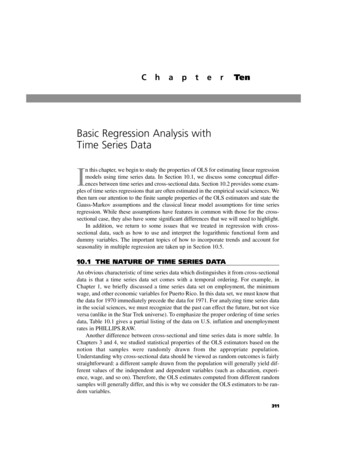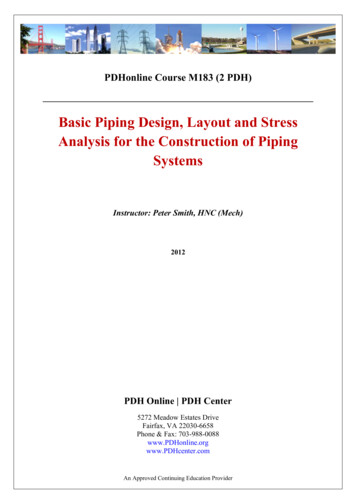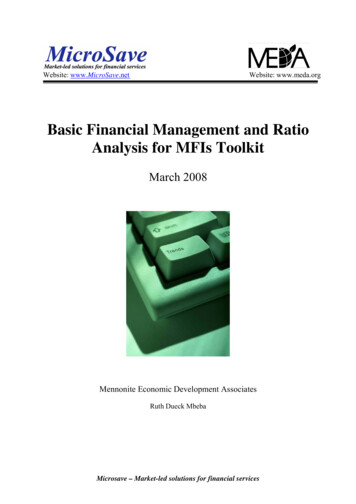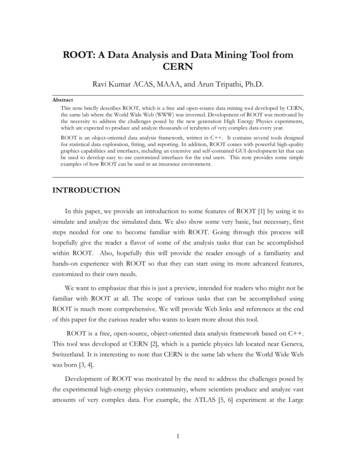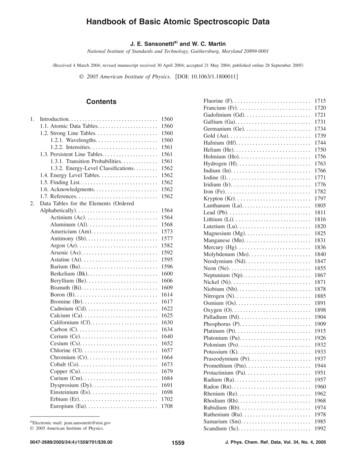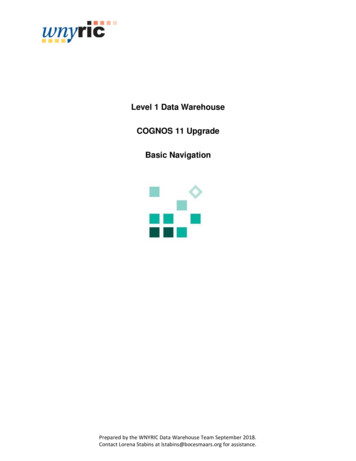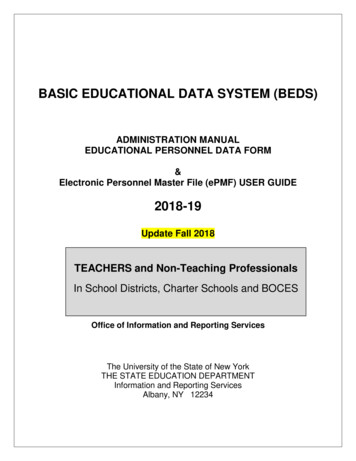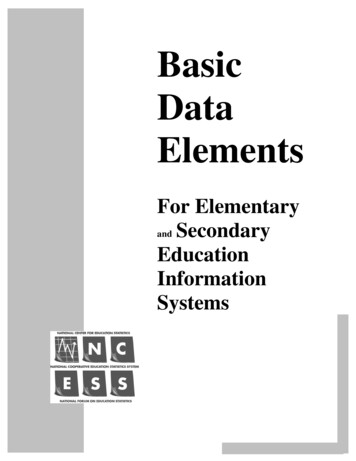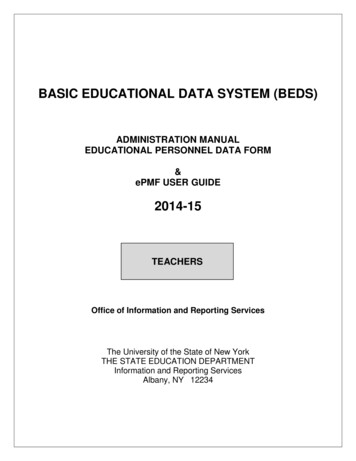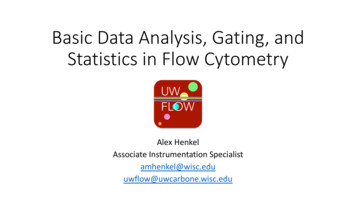
Transcription
Basic Data Analysis, Gating, andStatistics in Flow CytometryAlex HenkelAssociate Instrumentation du
Outline What is an FCS File? Visualization and Scaling Gating and Controls Basic Statistics in Flow Data The Process
The FCS File – Flow Cytometry Standard File Comprised of a text segment and data segment. FCS Files are in a list mode data format. Rows Events Columns Parameters H,A,W each get their own column. Annotate data before recording.
The FCS File - Header Header shows informationabout the data collection. Stores all the metadatafrom the instrument,including any added labels. Double clicking on thediamond next to a file inFlowJo will open the fileinformation, includingheader information.
Keywords All the header information canbe extracted as keywords in dataanalysis software, allowing youto group, or sort files bykeyword. Keywords can be added to tableswith sample statistics. Keywords can be metadata.
How does the cytometer generate values? Detection of light fromscatter or fluorescencein cells is convertedinto a voltage pulse.PinholeDetector Pathlaser 1Voltage inSignal intensityPhotocathodeDynodesAnode Values for H, A, and Wfrom each parameterstored in a listmodedata format in FCS file.1. EmissionSignal out2. DetectionTime3. Converted to Voltage800600# Cells Each pulse generatedby an object passingby the laser has aheight, area and widthmeasurement.Detector Pathlaser 24002000104. Measured5. File Generated0101FITC1021036. PlottedFrom Excyte Expert Cytometry
Visualization We can create several types of plots with the generated data. Histograms, dot plots, density plots, contour plots. We want to display the data in a way that relates to our hypothesis.
Histograms Shows the distribution of values for a specific parameter. Cannot see the relationship between two populations. Can miss sub-populations that have similar values in oneparameter.
Bi-variate Dot Plots Can see relationships between markers. Can see sub-populations from distinctions intwo dimensions instead of one.
Scaling Considerations Forward and Side scatter almost always displayed in linear scale. Exception for very small things like bacteria, extracellular vesicles, and nuclei. Use linear for small dynamic range. Fluorescence parameters almost always in log scale. Exception for low signal increase. Ex. Cell cycle assay will only have a two-fold increase influorescent intensity. Use log for large dynamic range.
Scaling Plots to Display Data Sometimes plots don’t display the data in the best way. Changing the scaling does not change the values, just the display ofthe data. Linear, Log, Biexponential, Hyperlog.LogLog w/ NegativeBiexponential – Extra negative decadesBiexponential – Proper extra negative decades
Adjusting Scaling in FlowJo
Adjusting Scaling in FCS Express
Basic Gating Considerations Gating on cells only Exclude debris. Doublet Discrimination Removes events that are two cells stucktogether. Live/Dead gating Dead cells soak up antibody. Each of these things lead to doublepositive or strange events!
Doublet Discrimination Helps remove eventsthat are two or morecells stuck together. Reduces contributionto false positive ordouble positiveevents.
Why Doublet Discrimination Works1232Cell MovementLaserLaser2SingleCell13Doublets13
Live/Dead GatingFrom Live gateFrom Dead gate
Gating Strategies General gating strategy Doesn’t have tobe in this order.UWCCC Flow Lab for Kirby Johnson, PhD
Common Gating Controls Fluorescence minus one (FMO) Control Gating control, shows the background and contributions fromneighboring fluorescence spillover. Positive Control Standardize gating procedure and observe staining profile. Treated to induce positivity. Biological Controls Stim vs. Unstim, T0 vs. Time course, Treated vs. Untreated. Any control you need to prove your hypothesis. Unstained control To evaluate inherent background and autofluorescence.
Negative and Positive controls slideUnstainedPositive ControlSample Positive controls Biological control to assess whatthe signal looks like when theantigen of interest is present. Useful for rare positivepopulations or when antigenexpression is variable betweensamples. Unstained/Negative control Helps make gating decisions. Visualizing autofluorescence.UnstainedSampleCourtesy of BiteSize BioOverlay
FMOsUnstained ControlFITC–PE––Cy5PEFMO ControlCD3–CD8Fully StainedCD3CD4CD810 510 410 3PEFMO BoundsUnstained Bounds10 210 110 010 010 110 210 310 410 010 110 210 310 410 010 110 210 310 4FITCFrom Excyte Expert Cytometry (Courtesy of M. Roederer, Ph.D, NIH Vaccine Center)
Why NOT Isotype Controls? Nearly impossible to determine if the isotype antibody has the samenumber of average fluorophores attached per Ab as experimental Ab. Different antibody than test sample, different binding properties. Maecker HT, and Trotter J. Flow cytometry controls, instrument setupand determination of positivity. Cytometry Part A 2006; 69A:1037–1042 Flow Server (T drive) Flowdata Flow Resources Flow References Isotypes. Can use isotype control to test how well the blocking buffer worked.
Basic Statistics in Flow Cytometry Typically described using frequencies and fluorescence intensity. Frequency Number of events in the target population within a larger population. MFI (Median Fluorescence Intensity) NOT mean. Mean is subject to outliers, median is less affected. Statistical modeling (Following Seminars) DNA Cell Cycle analysis Proliferation analysis Absolute counts Volumetric based acquisition cytometer or counting beads spiked in sample atknown concentration. (Counting beads tend to be problematic)
Frequency Ex. Number of CD4 cells in a population of Live, single, CD3 positive cells. Used to analyze presence of antigen/marker.From Live Single Cells49.81% of CD3 cells are CD4 44.86% of CD3 cells are CD8
Frequency HypothesesTreatment increases numbers ofcell type YCell type Y is more prevalent indisease state AReport % positive toevaluate changes incomposition of cellpopulations
Central TendencyMost flow cytometry data is displayed on a Logarithmic scale –What looks symmetrical is actually skewed!
Median Fluorescence IntensityTreatment increases expressionof protein XProtein X is upregulated indisease state Y Use the MFI to assess levelsof target protein expression Median for logarithmic data. Mean is ok for linear only. Standardizing your assay iscritical Reference Standard for PMTsensitivity (Rainbow Beads). Can compare samples run ondifferent days. /2017/03/Flow TechNotesRainbow-Standard-TechNote 20170918.pdf Fold increase?
Fold-change in MFI Used in comparison of expression level of86 468antigen/marker between samples. Fold-change in MFI MFI(sample)/MFI(control) Can compare fold-change in MFI betweentreatments/samples.Caution: In order to use Fold-change in MFI, need to be aware of potentialskewing of data due to log scale. Small changes in negative can translate into large changes in thefold.Control MFI 86Experimental MFI 468Fold-change in MFI 468/86 5.44
The Data Analysis Process1. Have a specific Hypothesis. ASK A SPECIFIC QUESTION!1. Need to know which statistics you are after.2. Gate on live, single cells and use controls to gate each fluorescentparameter.3. Gather statistics from plots and gates.4. Perform Analyses.
Acknowledgements Thank you to the DeLuca Lab for data used in this presentation. Excyte Expert Cytometry for graphics used in this presentation.
Mark your calendars for upcoming UWCCC Flow Lab Seminars!Rigor and Reproducibility inFlow CytometryOverview of Computational Data AnalysisPlatforms for Flow CytometryFriday, December 14, 201810am, WIMR 7001AFriday, January 11, 201910am, WIMR 7001AFlow Cytometry –Compensation with ConfidenceFriday February 1, 201910am, WIMR 7001AFlow Cytometry Current Best Practices for PIsThursday, February 14, 20197:30am, WIMR 7170Data Analysis with Alex IIMulticolor Panel Design for Flow CytometryTuesday, March 5, 20192pm, WIMR 7001ATuesday, March 7, 201910am, WIMR 7170Data Analysis with Alex IIIWednesday, May 16, 201910am, WIMR 7170flowcytometry.wisc.edu
Note_20170918.pdf Fold increase? Median Fluorescence Intensity. Fold-change in MFI Used in comparison of expression level of . Data Analysis with Alex II Tuesday, March 7, 2019 10am, WIMR 7170 Data Analysis with
